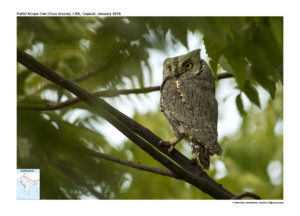
Pallid Scops Owl Otus brucei
Etymology:
- Otus : Latin word for eared Owl
- Brucei : Named after American missionary Revd Henry James Bruce (1835–1909)
Vernacular Names:Guj: Lintavalichuggad, Rekhaloyuggad, Mar: Kutruz, PandurkeShinglaGhubad
Distribution in India: Winters in North West India
Description: Size of 18–21 cm; wingspan of 54–64 cm; wt. of 100–110 g. It is a pale scops-owl with distinct fine streaking and short ear tufts. The facial disc is pale buffish-white, with thin dark border and short whitish eyebrows. The upperparts light greyish-brown with yellowish tinge, with sparse and fine black streaks, broader on crown and forehead, nape is with light ocher patch, scapulars are with blackish-edged white feathers; flight-feathers and tail are thinly barred. The underparts are paler and more heavily streaked with black, especially on center of breast. The tarsus are fully feathered to base of toes, irides are pale yellow; bill is greyish-horn.It is yellowish at base of lower mandible, toes are greyish-brown and claws are blackish-brown. Juvenile are pale, narrowly barred creamy and grey, shorter ear tufts.
Habitat: It is found in semi-open areas with trees and bushes, including cultivation, palm groves, orchards, riverine woodland; also parks and large gardens in towns. It is found from lowlands to 1500 m.
Food habits: It eats insects, such as beetles, moths, locusts and mole-crickets and spiders. It also eats small mammals, birds and lizards. It hunts from perch, dropping down to take prey from branch or ground; also pursues and catches aerial prey, such as moths and bats, on the wing.
Breeding habits: They breed in Apr–May in Middle East to West and Central Asia, to Jun in Uzbekistan .The nest is above ground in hollow tree, in old woodpecker hole, or in cavity in bank, wall, cliff or building. They lay a clutch of 4–6 eggs. The incubation period is 26–28 days and hatching asynchronous. Thefledgingperiod is 28–30 days.